Abstract
1. It has previously been shown that the antimigraine drug, sumatriptan, a putative 5-HT1D receptor agonist, decreases porcine common carotid and arteriovenous anastomotic blood flows, but slightly increases the arteriolar (capillary) blood flow to the skin and ears. Interestingly, such responses, being mediated by 5-HT1-like receptors, are resistant to blockade by metergoline, which, in addition to displaying a very high affinity for (and occasionally intrinsic efficacy at) the 5-HT1D receptor subtypes, blocks (with lower potency than methiothepin) some 5-HT1D receptor-mediated vascular responses. These findings raise doubts whether sumatriptan-sensitive 5-HT1-like receptors mediating changes in the distribution of porcine carotid blood flow are identical to cloned 5-HT1D receptors. With the recent advent of the potent and selective 5-HT1D receptor antagonist, GR127935, we have examined in the present study whether the carotid vascular effects of sumatriptan in the pig are amenable to blockade by GR127935. 2. In animals pretreated with saline, sumatriptan (30, 100 and 300 micrograms kg-1, i.v.) reduced the total carotid and arteriovenous anastomotic blood flows in a dose dependent manner. In contrast, sumatriptan increased blood flow to the skin, ears and fat, although the total capillary fraction was not significantly affected. 3. While GR127935 pretreatment (0.25 and 0.5 mg kg-1) itself slightly reduced the total carotid and arteriovenous anastomotic blood flows, carotid vasoconstrictor responses to sumatriptan were either partly (0.25 mg kg-1) or completely (0.5 mg kg-1) blocked by the compound. In GR127935 pretreated animals, the sumatriptan-induced increases in blood flow to the skin, ears and fat were also attenuated. 4. Taken together, the results suggest that arteriovenous anastomotic constriction and, possibly, arteriolar dilatation in the skin, ears and fat by sumatriptan are mediated by 5-HT1D receptors. Therefore, vascular 5-HT1-like receptors in the porcine carotid bed appear to be identical to 5-HT1D receptors.
Full text
PDF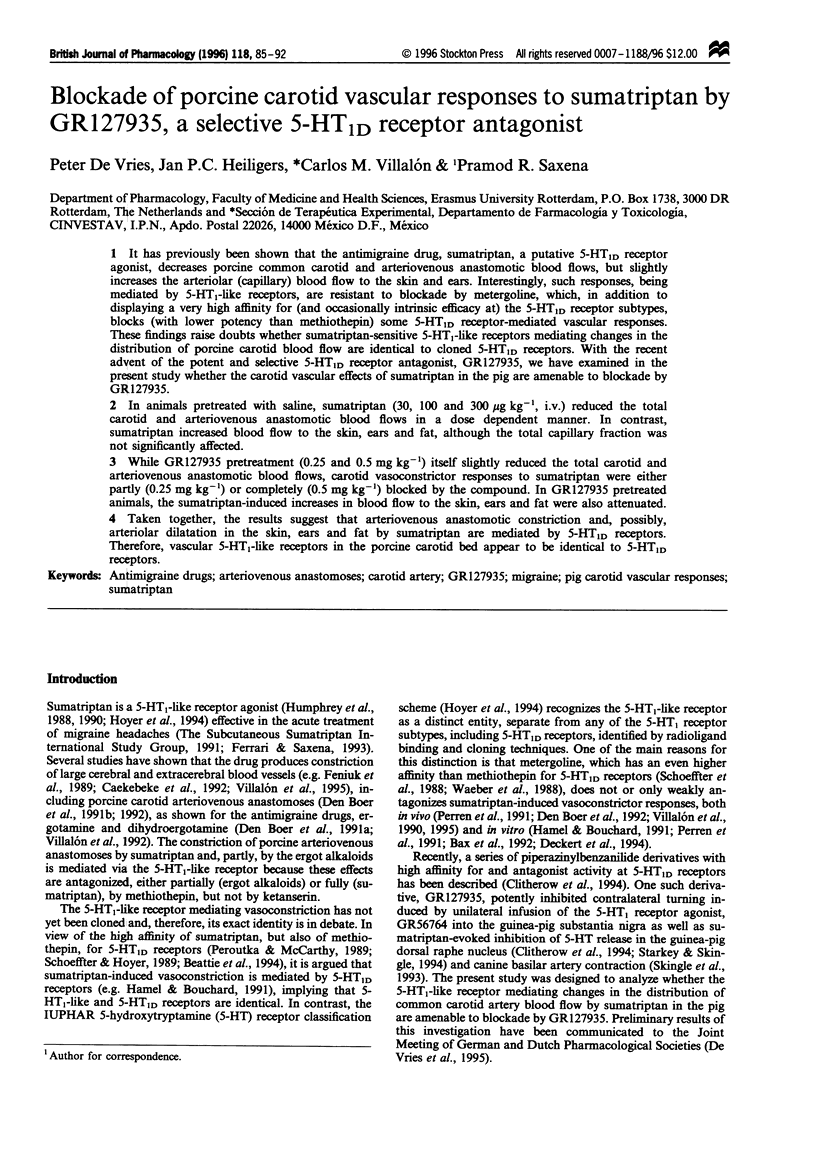
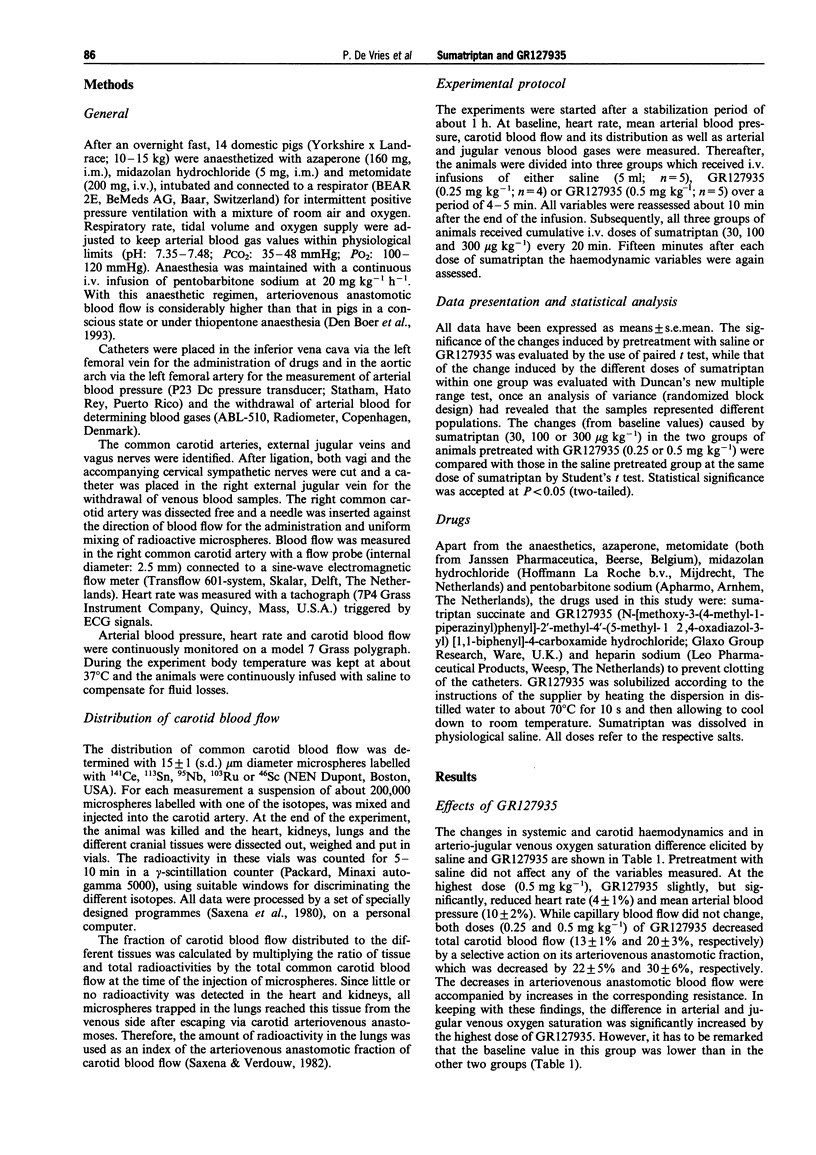
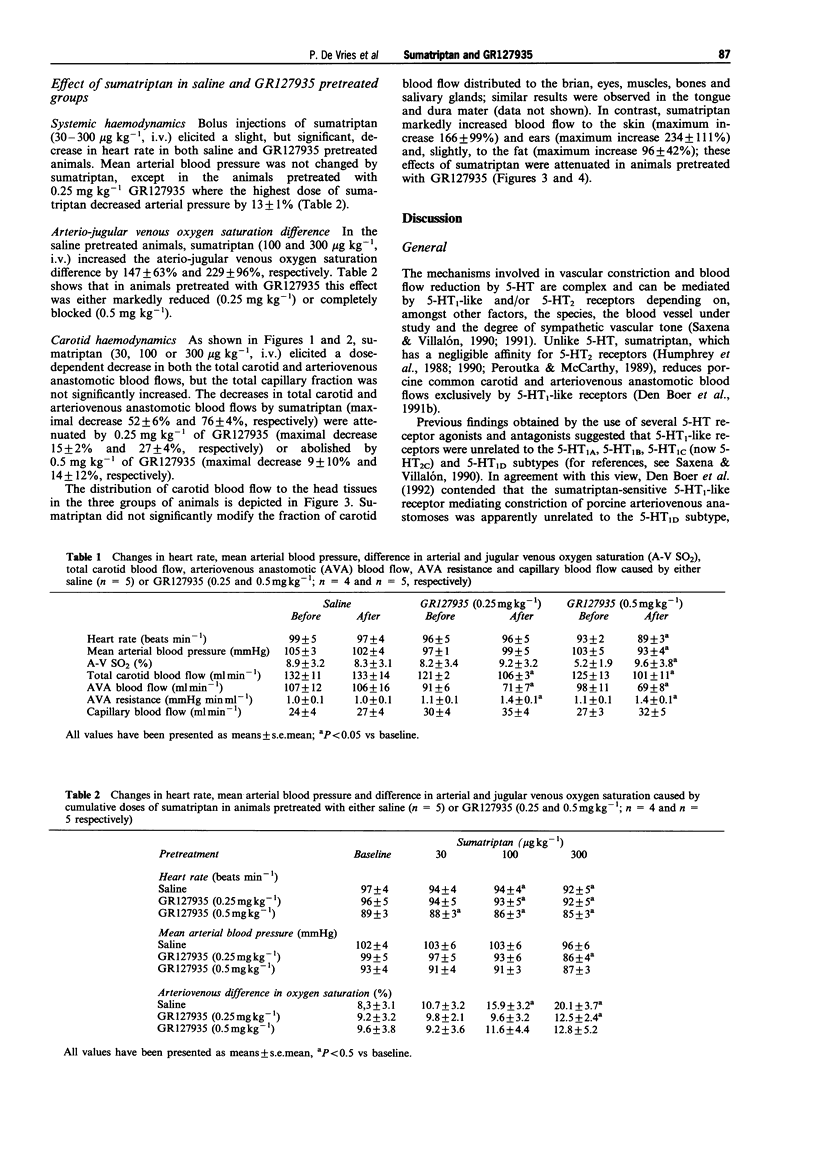
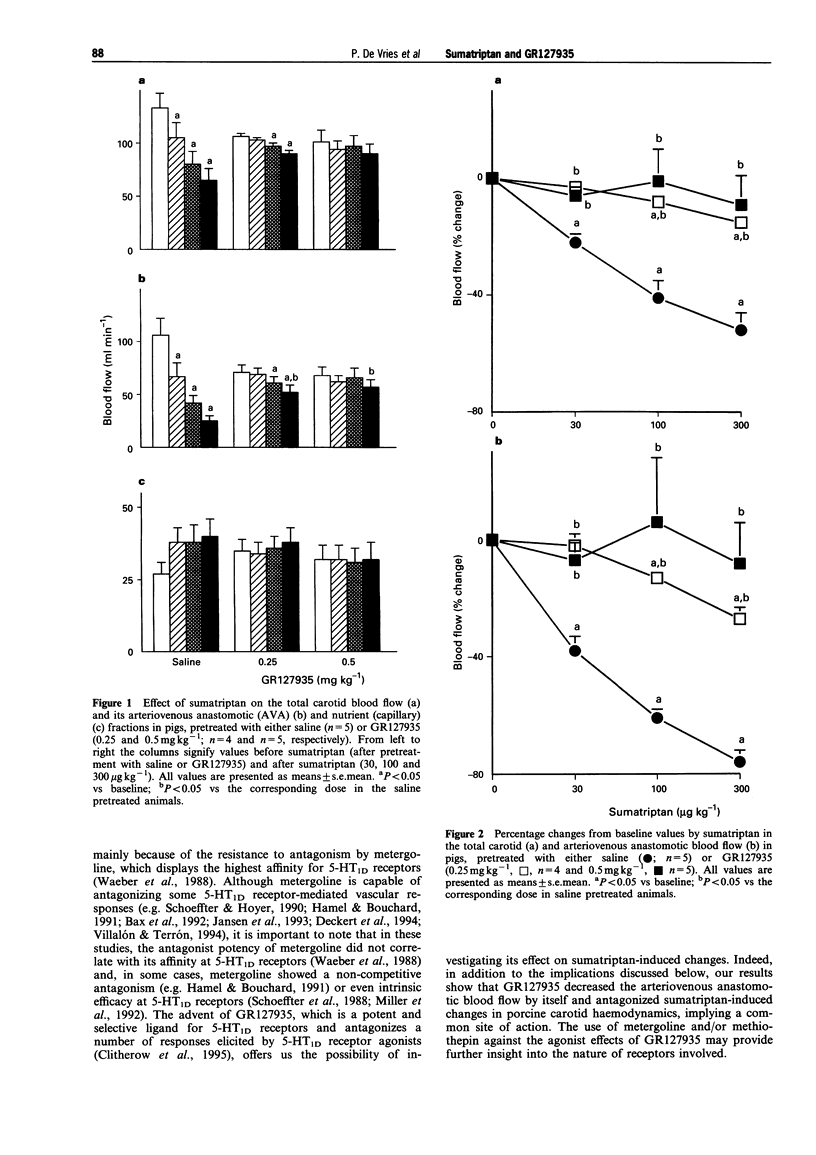
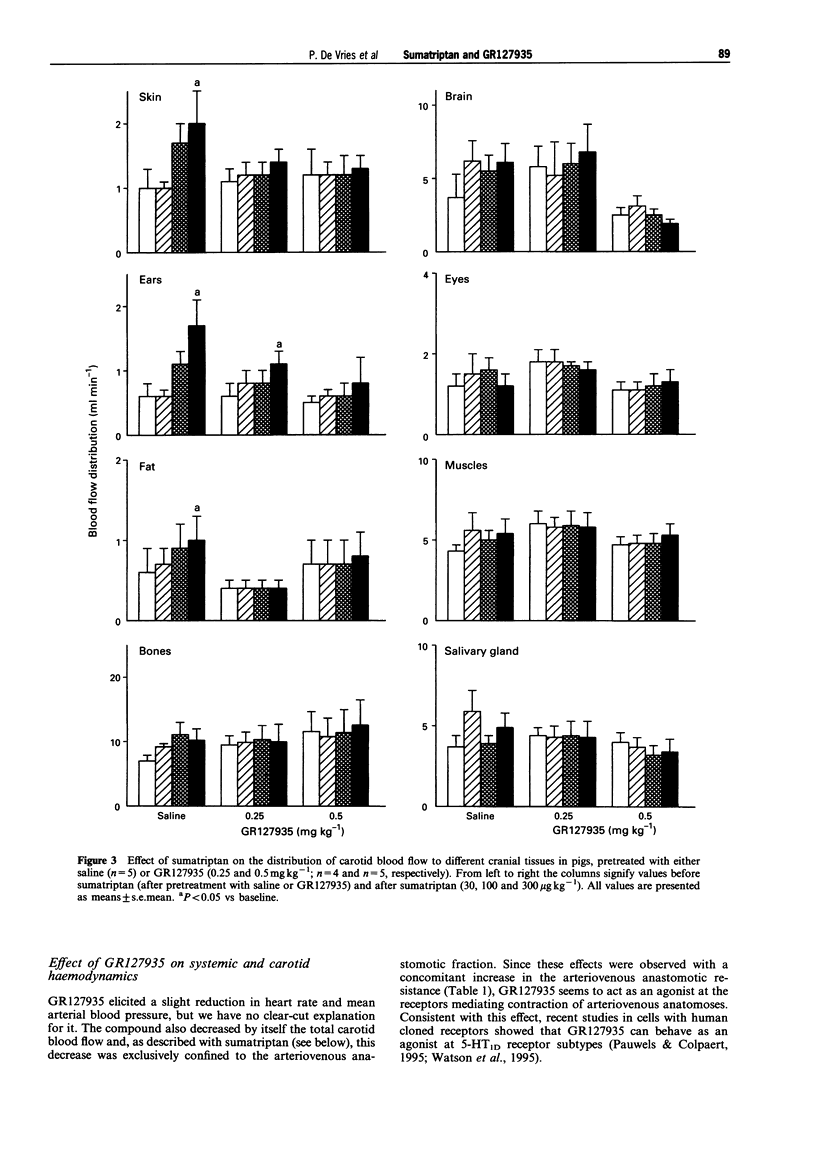
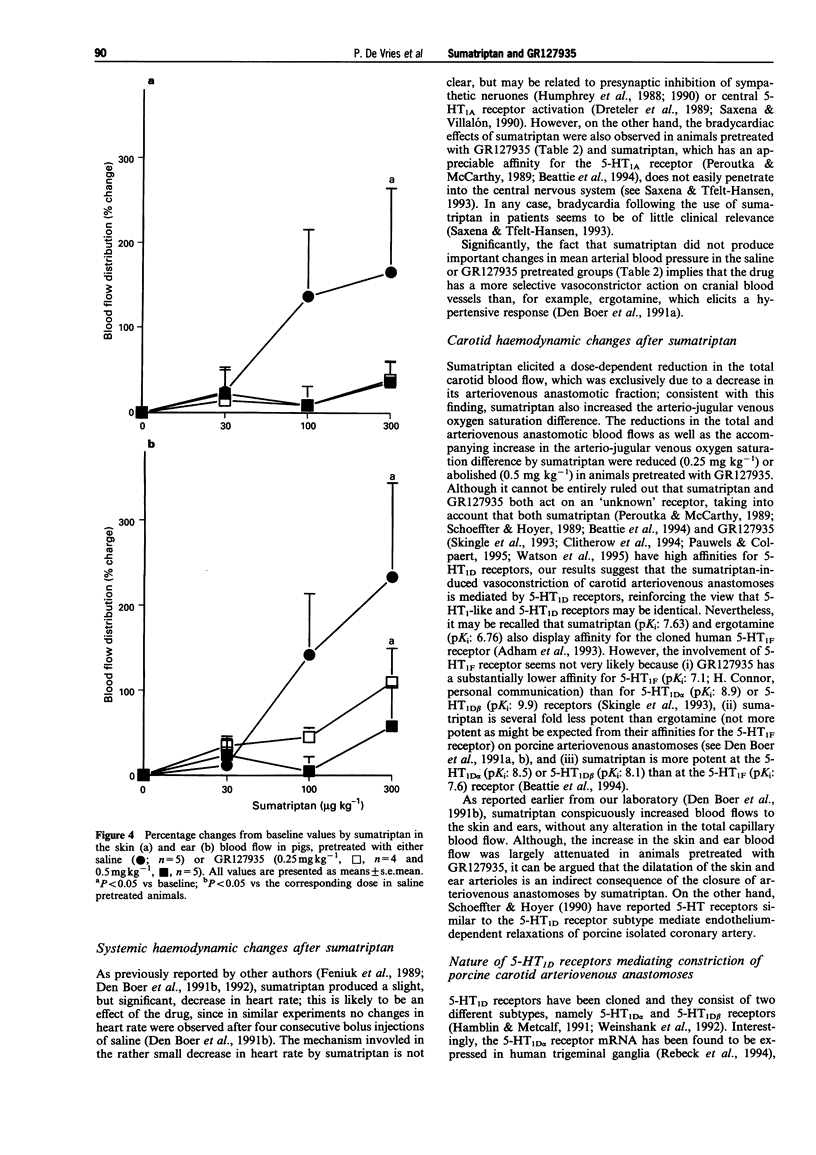
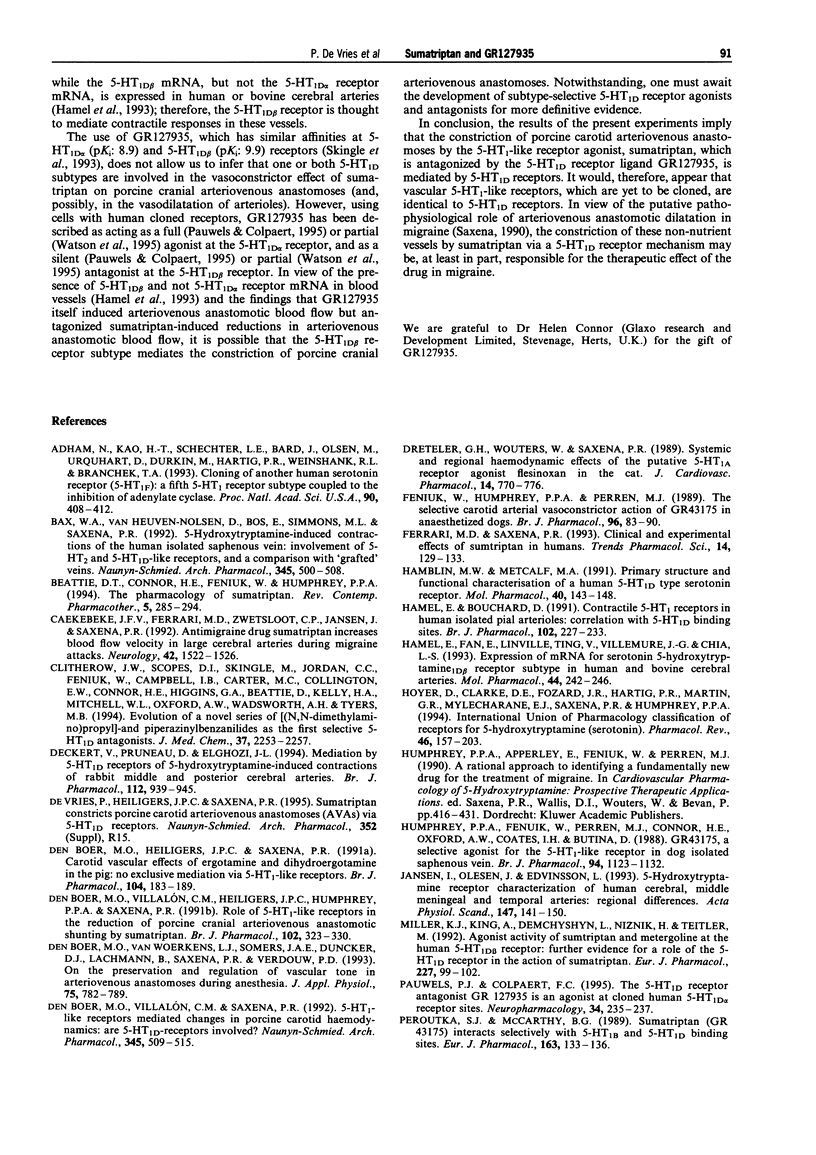
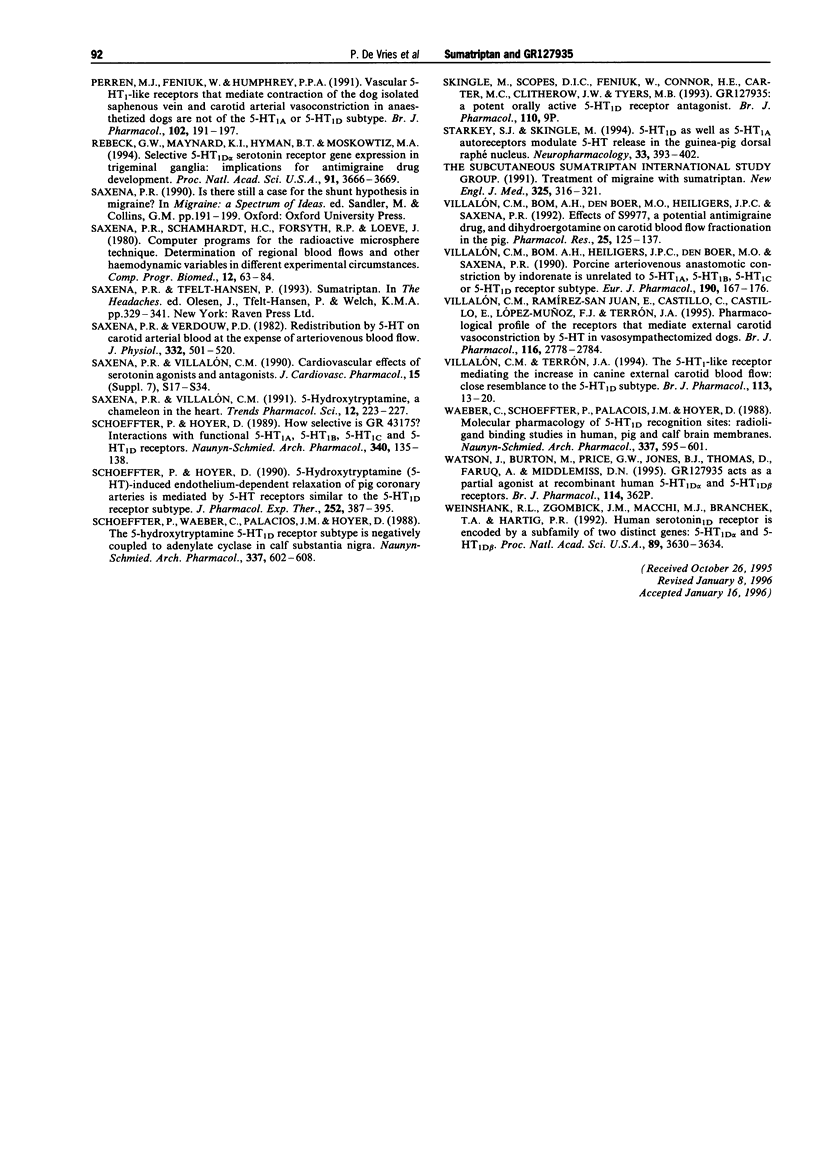
Selected References
These references are in PubMed. This may not be the complete list of references from this article.
- Adham N., Kao H. T., Schecter L. E., Bard J., Olsen M., Urquhart D., Durkin M., Hartig P. R., Weinshank R. L., Branchek T. A. Cloning of another human serotonin receptor (5-HT1F): a fifth 5-HT1 receptor subtype coupled to the inhibition of adenylate cyclase. Proc Natl Acad Sci U S A. 1993 Jan 15;90(2):408–412. doi: 10.1073/pnas.90.2.408. [DOI] [PMC free article] [PubMed] [Google Scholar]
- Bax W. A., Van Heuven-Nolsen D., Bos E., Simoons M. L., Saxena P. R. 5-Hydroxytryptamine-induced contractions of the human isolated saphenous vein: involvement of 5-HT2 and 5-HT1D-like receptors, and a comparison with grafted veins. Naunyn Schmiedebergs Arch Pharmacol. 1992 May;345(5):500–508. doi: 10.1007/BF00168940. [DOI] [PubMed] [Google Scholar]
- Caekebeke J. F., Ferrari M. D., Zwetsloot C. P., Jansen J., Saxena P. R. Antimigraine drug sumatriptan increases blood flow velocity in large cerebral arteries during migraine attacks. Neurology. 1992 Aug;42(8):1522–1526. doi: 10.1212/wnl.42.8.1522. [DOI] [PubMed] [Google Scholar]
- Clitherow J. W., Scopes D. I., Skingle M., Jordan C. C., Feniuk W., Campbell I. B., Carter M. C., Collington E. W., Connor H. E., Higgins G. A. Evolution of a novel series of [(N,N-dimethylamino)propyl]- and piperazinylbenzanilides as the first selective 5-HT1D antagonists. J Med Chem. 1994 Jul 22;37(15):2253–2257. doi: 10.1021/jm00041a001. [DOI] [PubMed] [Google Scholar]
- Deckert V., Pruneau D., Elghozi J. L. Mediation by 5-HT1D receptors of 5-hydroxytryptamine-induced contractions of rabbit middle and posterior cerebral arteries. Br J Pharmacol. 1994 Jul;112(3):939–945. doi: 10.1111/j.1476-5381.1994.tb13171.x. [DOI] [PMC free article] [PubMed] [Google Scholar]
- Den Boer M. O., Van Woerkens L. J., Somers J. A., Duncker D. J., Lachmann B., Saxena P. R., Verdouw P. D. On the preservation and regulation of vascular tone in arteriovenous anastomoses during anesthesia. J Appl Physiol (1985) 1993 Aug;75(2):782–789. doi: 10.1152/jappl.1993.75.2.782. [DOI] [PubMed] [Google Scholar]
- Den Boer M. O., Villalón C. M., Saxena P. R. 5-HT1-like receptor mediated changes in porcine carotid haemodynamics: are 5-HT1D receptors involved? Naunyn Schmiedebergs Arch Pharmacol. 1992 May;345(5):509–515. doi: 10.1007/BF00168941. [DOI] [PubMed] [Google Scholar]
- Dreteler G. H., Wouters W., Saxena P. R. Systemic and regional hemodynamic effects of the putative 5-HT1A receptor agonist flesinoxan in the cat. J Cardiovasc Pharmacol. 1989 Nov;14(5):770–776. doi: 10.1097/00005344-198911000-00014. [DOI] [PubMed] [Google Scholar]
- Feniuk W., Humphrey P. P., Perren M. J. The selective carotid arterial vasoconstrictor action of GR43175 in anaesthetized dogs. Br J Pharmacol. 1989 Jan;96(1):83–90. doi: 10.1111/j.1476-5381.1989.tb11787.x. [DOI] [PMC free article] [PubMed] [Google Scholar]
- Ferrari M. D., Saxena P. R. Clinical and experimental effects of sumatriptan in humans. Trends Pharmacol Sci. 1993 Apr;14(4):129–133. doi: 10.1016/0165-6147(93)90084-w. [DOI] [PubMed] [Google Scholar]
- Hamblin M. W., Metcalf M. A. Primary structure and functional characterization of a human 5-HT1D-type serotonin receptor. Mol Pharmacol. 1991 Aug;40(2):143–148. [PubMed] [Google Scholar]
- Hamel E., Bouchard D. Contractile 5-HT1 receptors in human isolated pial arterioles: correlation with 5-HT1D binding sites. Br J Pharmacol. 1991 Jan;102(1):227–233. doi: 10.1111/j.1476-5381.1991.tb12158.x. [DOI] [PMC free article] [PubMed] [Google Scholar]
- Hamel E., Fan E., Linville D., Ting V., Villemure J. G., Chia L. S. Expression of mRNA for the serotonin 5-hydroxytryptamine1D beta receptor subtype in human and bovine cerebral arteries. Mol Pharmacol. 1993 Aug;44(2):242–246. [PubMed] [Google Scholar]
- Hoyer D., Clarke D. E., Fozard J. R., Hartig P. R., Martin G. R., Mylecharane E. J., Saxena P. R., Humphrey P. P. International Union of Pharmacology classification of receptors for 5-hydroxytryptamine (Serotonin). Pharmacol Rev. 1994 Jun;46(2):157–203. [PubMed] [Google Scholar]
- Humphrey P. P., Feniuk W., Perren M. J., Connor H. E., Oxford A. W., Coates L. H., Butina D. GR43175, a selective agonist for the 5-HT1-like receptor in dog isolated saphenous vein. Br J Pharmacol. 1988 Aug;94(4):1123–1132. doi: 10.1111/j.1476-5381.1988.tb11630.x. [DOI] [PMC free article] [PubMed] [Google Scholar]
- Jansen I., Olesen J., Edvinsson L. 5-Hydroxytryptamine receptor characterization of human cerebral, middle meningeal and temporal arteries: regional differences. Acta Physiol Scand. 1993 Feb;147(2):141–150. doi: 10.1111/j.1748-1716.1993.tb09483.x. [DOI] [PubMed] [Google Scholar]
- Miller K. J., King A., Demchyshyn L., Niznik H., Teitler M. Agonist activity of sumatriptan and metergoline at the human 5-HT1D beta receptor: further evidence for a role of the 5-HT1D receptor in the action of sumatriptan. Eur J Pharmacol. 1992 Sep 1;227(1):99–102. doi: 10.1016/0922-4106(92)90149-p. [DOI] [PubMed] [Google Scholar]
- Pauwels P. J., Colpaert F. C. The 5-HT1D receptor antagonist GR 127,935 is an agonist at cloned human 5-HT1D alpha receptor sites. Neuropharmacology. 1995 Feb;34(2):235–237. doi: 10.1016/0028-3908(95)00007-s. [DOI] [PubMed] [Google Scholar]
- Peroutka S. J., McCarthy B. G. Sumatriptan (GR 43175) interacts selectively with 5-HT1B and 5-HT1D binding sites. Eur J Pharmacol. 1989 Apr 12;163(1):133–136. doi: 10.1016/0014-2999(89)90406-8. [DOI] [PubMed] [Google Scholar]
- Perren M. J., Feniuk W., Humphrey P. P. Vascular 5-HT1-like receptors that mediate contraction of the dog isolated saphenous vein and carotid arterial vasoconstriction in anaesthetized dogs are not of the 5-HT1A or 5-HT1D subtype. Br J Pharmacol. 1991 Jan;102(1):191–197. doi: 10.1111/j.1476-5381.1991.tb12152.x. [DOI] [PMC free article] [PubMed] [Google Scholar]
- Rebeck G. W., Maynard K. I., Hyman B. T., Moskowitz M. A. Selective 5-HT1D alpha serotonin receptor gene expression in trigeminal ganglia: implications for antimigraine drug development. Proc Natl Acad Sci U S A. 1994 Apr 26;91(9):3666–3669. doi: 10.1073/pnas.91.9.3666. [DOI] [PMC free article] [PubMed] [Google Scholar]
- Saxena P. R., Schamhardt H. C., Forsyth R. P., Hoeve J. Computer programs for the radioactive microsphere technique. Determination of regional blood flows and other haemodynamic variables in different experimental circumstances. Comput Programs Biomed. 1980 Dec;12(2-3):63–84. doi: 10.1016/0010-468x(80)90053-7. [DOI] [PubMed] [Google Scholar]
- Saxena P. R., Verdouw P. D. Redistribution by 5-hydroxytryptamine of carotid arterial blood at the expense of arteriovenous anastomotic blood flow. J Physiol. 1982 Nov;332:501–520. doi: 10.1113/jphysiol.1982.sp014427. [DOI] [PMC free article] [PubMed] [Google Scholar]
- Saxena P. R., Villalón C. M. 5-Hydroxytryptamine: a chameleon in the heart. Trends Pharmacol Sci. 1991 Jun;12(6):223–227. doi: 10.1016/0165-6147(91)90556-8. [DOI] [PubMed] [Google Scholar]
- Saxena P. R., Villalón C. M. Cardiovascular effects of serotonin agonists and antagonists. J Cardiovasc Pharmacol. 1990;15 (Suppl 7):S17–S34. [PubMed] [Google Scholar]
- Schoeffter P., Hoyer D. 5-Hydroxytryptamine (5-HT)-induced endothelium-dependent relaxation of pig coronary arteries is mediated by 5-HT receptors similar to the 5-HT1D receptor subtype. J Pharmacol Exp Ther. 1990 Jan;252(1):387–395. [PubMed] [Google Scholar]
- Schoeffter P., Hoyer D. How selective is GR 43175? Interactions with functional 5-HT1A, 5-HT1B, 5-HT1C and 5-HT1D receptors. Naunyn Schmiedebergs Arch Pharmacol. 1989 Jul;340(1):135–138. doi: 10.1007/BF00169219. [DOI] [PubMed] [Google Scholar]
- Schoeffter P., Waeber C., Palacios J. M., Hoyer D. The 5-hydroxytryptamine 5-HT1D receptor subtype is negatively coupled to adenylate cyclase in calf substantia nigra. Naunyn Schmiedebergs Arch Pharmacol. 1988 Jun;337(6):602–608. doi: 10.1007/BF00175784. [DOI] [PubMed] [Google Scholar]
- Starkey S. J., Skingle M. 5-HT1D as well as 5-HT1A autoreceptors modulate 5-HT release in the guinea-pig dorsal raphé nucleus. Neuropharmacology. 1994 Mar-Apr;33(3-4):393–402. doi: 10.1016/0028-3908(94)90069-8. [DOI] [PubMed] [Google Scholar]
- Villalón C. M., Bom A. H., Den Boer M. O., Heiligers J. P., Saxena P. R. Effects of S9977 and dihydroergotamine in an animal experimental model for migraine. Pharmacol Res. 1992 Feb-Mar;25(2):125–137. doi: 10.1016/1043-6618(92)91381-p. [DOI] [PubMed] [Google Scholar]
- Villalón C. M., Bom A. H., Heiligers J. P., Den Boer M. O., Saxena P. R. Constriction of porcine arteriovenous anastomoses by indorenate is unrelated to 5-HT1A, 5-HT1B, 5-HT1C or 5-HT1D receptor subtypes. Eur J Pharmacol. 1990 Nov 6;190(1-2):167–176. doi: 10.1016/0014-2999(90)94123-f. [DOI] [PubMed] [Google Scholar]
- Villalón C. M., Ramírez-San Juan E., Castillo C., Castillo E., López-Muñoz F. J., Terrón J. A. Pharmacological profile of the receptors that mediate external carotid vasoconstriction by 5-HT in vagosympathectomized dogs. Br J Pharmacol. 1995 Nov;116(6):2778–2784. doi: 10.1111/j.1476-5381.1995.tb17241.x. [DOI] [PMC free article] [PubMed] [Google Scholar]
- Villalón C. M., Terrón J. A. The 5-HT1-like receptor mediating the increase in canine external carotid blood flow: close resemblance to the 5-HT1D subtype. Br J Pharmacol. 1994 Sep;113(1):13–20. doi: 10.1111/j.1476-5381.1994.tb16167.x. [DOI] [PMC free article] [PubMed] [Google Scholar]
- Waeber C., Schoeffter P., Palacios J. M., Hoyer D. Molecular pharmacology of 5-HT1D recognition sites: radioligand binding studies in human, pig and calf brain membranes. Naunyn Schmiedebergs Arch Pharmacol. 1988 Jun;337(6):595–601. doi: 10.1007/BF00175783. [DOI] [PubMed] [Google Scholar]
- Weinshank R. L., Zgombick J. M., Macchi M. J., Branchek T. A., Hartig P. R. Human serotonin 1D receptor is encoded by a subfamily of two distinct genes: 5-HT1D alpha and 5-HT1D beta. Proc Natl Acad Sci U S A. 1992 Apr 15;89(8):3630–3634. doi: 10.1073/pnas.89.8.3630. [DOI] [PMC free article] [PubMed] [Google Scholar]
- den Boer M. O., Heiligers J. P., Saxena P. R. Carotid vascular effects of ergotamine and dihydroergotamine in the pig: no exclusive mediation via 5-HT1-like receptors. Br J Pharmacol. 1991 Sep;104(1):183–189. doi: 10.1111/j.1476-5381.1991.tb12405.x. [DOI] [PMC free article] [PubMed] [Google Scholar]
- den Boer M. O., Villalón C. M., Heiligers J. P., Humphrey P. P., Saxena P. R. Role of 5-HT1-like receptors in the reduction of porcine cranial arteriovenous anastomotic shunting by sumatriptan. Br J Pharmacol. 1991 Feb;102(2):323–330. doi: 10.1111/j.1476-5381.1991.tb12173.x. [DOI] [PMC free article] [PubMed] [Google Scholar]


